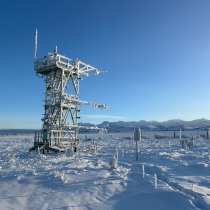Data Notification
Data Impacts for NEON’s Yellowstone Sites (YELL, BLDE) due to Catastrophic Flooding - Update
April 10, 2023
This is an update to the earlier data notification, "Data Impacts for NEON’s Yellowstone Sites (YELL, BLDE) due to Catastrophic Flooding" in August 2022, which notified users of the gaps in data collection resulting from both power loss and extreme road damage that resulted from the flooding.
As of October 31, 2022, the National Park Service opened a newly constructed road from Gardiner, MT to Mammoth, WY with minimal restrictions. Consequently, beginning on that date, normal operations in Domain 12 at YELL and BLDE were able to resume.
Terrestrial and Aquatic Observation System (TOS and AOS) Data Impacts
NEON Domain 12 completed Vegetation Structure measurements at a subset of tower plots from late August through September 2022. These measurements were taken at five Vegetation Structure Plots. All dendrometer band measurements were also collected. All other TOS sampling for the remainder of 2022 was cancelled due to not meeting protocol requirements related to snow cover and temperature after site access was restored.
Domain 12 also performed a subset of AOS activities such as Surface Water Chemistry and Surface Water Microbes from mid-November through the rest of 2022. All other AOS sampling for 2022 was cancelled due to Blacktail Deer Creek icing over in late-October 2022.
Terrestrial and Aquatic Instrument System (TIS and AIS) Data Impacts
The immediate impact of the Yellowstone flood on NEON instrumentation was approximately 30 hours of missed data due to a widespread power outage. The subsequent inability to access the field sites had an ongoing impact, including missed calibrations, delays in replacing damaged sensors/cables, and sensors not being cleaned and maintained on a regular basis.
For the Aquatic instruments in particular, the inaccessibility of the Blacktail Deer Creek field site prevented NEON Field Ecologists from calibrating the SUNA (nitrate sensor) and the Sondes (water quality sensors). SUNA and pH data missed scheduled calibrations on July 1, and conductivity, turbidity, dissolved organic matter, and dissolved oxygen measurements missed calibrations on August 1. Field Ecologists were able to do a corrective maintenance and site assessment visit on August 8 and found significant debris creating dams on NEON infrastructure. This debris was removed, and the support structures held with minimal damage from the flood, with sensor failures discovered only for a datalogger, a temperature sensor, the SUNA cable, and the pressure sensor measuring water level at groundwater well 7. The SUNA and Sondes were able to be calibrated for the first time since the flood on October 18. During this visit it was also noted that the meteorology station’s mast had been bent in half while field ecologists were away from the site, likely by bison in September 2022. The station was rebuilt in November 2022, and solar radiation data collected from September to November 2022 has been flagged accordingly.
The biggest impacts to the YELL flux tower were due to the extended absence of Field Ecologists and the resulting lack of maintenance. The flood occurred while the Yellowstone Tower was inaccessible for maintenance due to a Bear Management Area closure, which takes place annually from March 10 to June 30. Wet Deposition measurements were suspended as usual for the closure, but these measurements were not restarted as scheduled in early July. They were suspended until regular access to the site was restored in November 2022. Maintenance that was delayed due to the annual closure was further delayed until August, when technicians and ecologists were able to return to the tower for limited visits.
During this extended closure, several instruments failed that could not be repaired in the planned timeframe, but most of these issues were resolved by field visits by NEON staff during the weeks of August 8 and August 22. Sufficient access to the instrumentation sites to preventatively clean sensors, replace gas inlet filters, and recharge desiccants was restored in November 2022. Annual sensor refresh at YELL was scheduled for early September, but instead was largely completed over the winter. Soil plots were inaccessible due to snow cover by the time site access was restored, delaying refresh of soil sensors to summer 2023.

